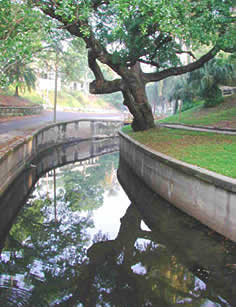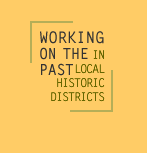
 |
||||||




"Local Design Guidelines are a part of a longstanding tradition of balancing the welfare of the general public and the interests of individual property owners. Local preservation ordinances, zoning laws, and building codes are other tools traditionally used to maintain this balance. They are not intended to prevent property owners from making changes to their property. They are meant to ensure that those changes enhance the historic qualities that are enjoyed by all members of the community and which make an area a special place in which to live and work. Depending on the powers outlined in the ordinance and the particular needs of the district, design guidelines can range from recommended design approaches to compulsory standards. Of course, there are many intermediate levels in between…" This page adapted from an Information Sheet: Historic District Design Guidelines, Georgia Department of Natural Resources, 1985. |
First, think about how you are going to use the design guidelines. Remember—the ordinance is a law and the design review criteria are part of the law. Design guidelines are not, in and of themselves, mandatory like the ordinance and should not be confused with the ordinance. In most cases, guidelines are just that—helpful, interpretive, explanatory recommendations. Recognize that if you call it a "guideline," you should not deny a work proposal just for failing to meet the guideline. A guideline is advisory. If you wish to describe a basis for denying an application, call it a criterion, standard, or some other term that makes clear that it is a requirement and make it part of your ordinance.
Who should be on your writing team?
The first order of business is to put together a team to draft
your local design guidelines. Be sure to engage knowledgeable and committed
people in your guidelines work group, e.g., preservationists, district
residents, policy setting officials, and code inspectors. Architects,
preservation consultants, urban planners, lawyers, and other professionals
should be consulted and can provide invaluable ideas on the substance
and effect of the proposed language.
 |
ONE / Analyze your district's character. It is essential to have a clear understanding of the history of the district and how that history is reflected by its physical characteristics, such as the architecture, landscape, and street plan. Ideally, the buildings, streetscapes, and setting should be identified in the district's nomination package. Has the district evolved over time or does it represent one period in time? Decide exactly what it is that needs to be protected!
TWO / Identify historic preservation goals and district needs. Will buildings in the district be preserved, as is; or rehabilitated for new uses; or restored to an earlier appearance? Will different approaches to work be applied, depending upon the significance, use, and interpretation? In this section, identify the approach or approaches to work that will protect the historical value and significant features of the district, e.g., preservation, rehabilitation, or restoration. Include general Standards or principles for all treatments for which guidelines will be written. Guidelines, however, should be custom-tailored to the particular history and characteristics of the district. For example, if a town has six districts and they differ in appearance and the kinds of work needed to protect them, then each one should have a specific set of guidelines.
THREE / Review other district guidelines. See how other historic districts have developed design guidelines in order to prevent "reinventing the wheel." Choose basic elements that apply to your own historic district and adapt them to yours. Especially note successful methods of illustrating preservation concepts.
FOUR / Write specific guidelines for your district. Design guidelines should address the special character of your district and the work needed to protect it. Draft an illustrated history that identifies significant characteristics and features of the district, such as buildings, streetscapes, and landscapes. The use of photos and drawings throughout to reinforce key points is strongly recommended. Information on materials maintenance, repair and replacement should be included, as well as guidance on new construction in the district. If restoration is a recommended treatment for the district, guidelines on those approaches should be included. Make guidance on the treatment of streetscape (including signage) and landscape features an integral part of the publication.
FIVE / Review your design guidelines. While in final draft, review the guidelines, asking a number of questions: Are they consistent with the provisions of the local ordinance? Do they achieve the original goals? Are there administrative problems? Do they conflict with the ordinance and other codes? If the Secretary of the Interior's Standards are used, do your guidelines agree with the principles in the Standards? Are they consistent with the particular needs of the district? Will the guidelines meet with community support? How do we want to use the guidelines? Are they truly advisory in nature or should we call them "standards" or "criteria" because we want to make them requirements? Answering questions like these can prevent problems that might otherwise arise later.
---------------------------------